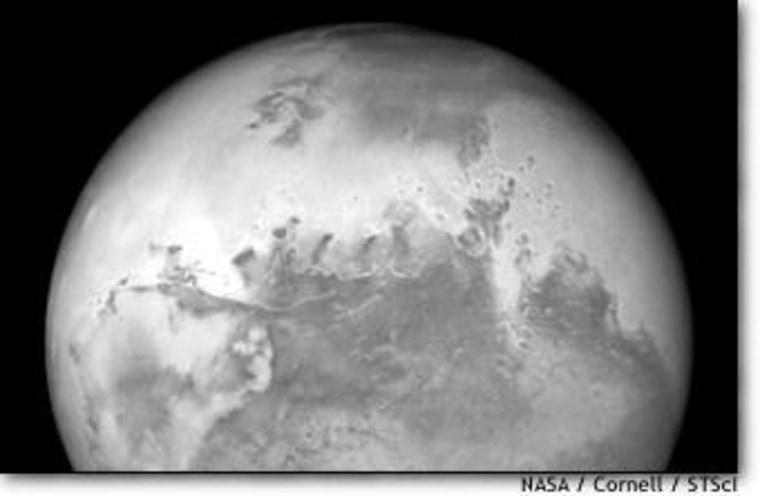NASA released a pair of highly anticipated Mars portraits from the Hubble Space Telescope on Wednesday as the observatory’s operators took advantage of a proximity to the Red Planet not equaled in 59,619 years.
The first color photograph, released early in the morning, includes Mars’ Hellas Basin, a huge impact crater, and the southern polar ice cap is unmistakable.
The second image shows Mars’ version of the Grand Canyon, called Valles Marineris, a vast system of gorges and side canyons that stretches across 2,485 miles (4,000 kilometers) of the Martian surface. If you dropped Valles Marineris on the United States, it would reach nearly coast to coast.
The two pictures are the most detailed full-globe shots of Mars ever obtained from Earth’s vicinity.
“These images are likely to be the ones that appear in astronomy textbooks for the next decade to century because they are the best resolution we can get from Earth for a long time,” said Cornell University astronomer Jim Bell.
Not until 2287 will the two worlds be so close again.
On Tuesday night, while skywatchers around the world were staring up at Mars, Hubble spent 52 minutes gathering 10 separate exposures for the first color shot.
Photo experts at the Space Telescope Science Institute scrambled to assemble the first picture and colorize it. They also had to adjust each frame to account for the fact that Mars did not sit still during the photo shoot — it was rotating upon its axis, as always.
The result is a sharp image revealing details as small as 17 miles (24 kilometers) wide. Several impact craters are visible.
Hellas Basin, just below and to the right of the image center, is about 1,240 miles across (2,000 kilometers) and 4.4 miles (7 kilometers) deep. It’s so far down from rim to floor that sometimes pictures of it are blurry just because there is so much more air in the basin than above other parts of Mars. The basin is also frequently clouded over and thus even more obscured. But it was clear last night.
The color picture of the hemisphere showing Valles Marineris was taken around 5:51 a.m. ET Wednesday, in a similar amount of exposure time, to coincide with the moment when Earth and Mars would be closest.
Still the brightest 'star'
Mars, meanwhile, continues to beckon casual observers as well as seasoned backyard astronomers.
It is the unmistakably bright “star” of the night sky now, rising in the southeast at sunset and setting in the southwest at dawn. Around midnight, it is high in the southern sky. Though Mars and Earth are now gradually drifting apart, the Red Planet remains at peak brightness through Sept. 2 and will be a compelling night sky target into October.
Mars’ orange tint, sometimes seen as red, is created by a global coating of iron oxide, commonly called rust.
Hubble vs. Mars orbiters
NASA has two orbiting spacecraft at Mars, and each can snap higher-resolution pictures compared with Hubble’s effort.
But the orbiters photograph just strips of Mars at a time. Even when the strips are stitched together to make a globe, the result is unnatural, showing all parts of the surface at the same time of day — the time when the robots are in position to make images. In the case of Mars Global Surveyor, each strip of the surface is seen as of early afternoon local time on the ground.
“With Hubble, you get the whole globe view of weather from the morning terminator to evening limb,” Bell said in a telephone interview last week. “You can really characterize the whole nature of cloud motion, dynamics of the atmosphere and wind speeds.”
Hubble records sunrise on one edge of the disk facing Earth, sunset on the other, and all times of day in between.
Included in the data collected for the new images are ultraviolet observations by Hubble. UV pictures of Mars can’t be made from the surface of Earth, because that wavelength of light is filtered by Earth’s atmosphere. Mars orbiters aren’t equipped for the task either.
Hubble, orbiting Earth above the atmosphere, also gathered exclusive data in the near-infrared.
Bell expects the observations to contribute to a larger effort to understand ozone in the thin Martian atmosphere, as well as to studies about iron-bearing minerals and other characterizations of the dusty surface.
The Hubble pictures represent “enormous advantages” over data collected by the Mars orbiters, Bell said, though images and other measurements from the orbiters are invaluable in their own way.
More about the images
In the Hellas Basin globe shot, two dominant dark regions on the surface have long been noted by astronomers. The “shark-fin” shape to the right is Syrtis Major. The horizontal lane to the left is Sinus Meridiani. NASA’s Opportunity rover is scheduled to land at the western end of this region in January 2004.
A lack of water-ice clouds at middle latitudes shows that it is a relatively warm summer in the southern hemisphere, Hubble scientists said. Even so, daytime highs are just above freezing in the Hellas impact basin.
The south polar ice cap is currently melting and shrinking in size. It is winter in the north of Mars, and a hood of cold polar clouds covers the northern cap.
The second image, which includes Valles Marineris, also features Olympus Mons, a towering volcano that dwarfs any on Earth.

The color pictures were made using Hubble’s Wide Field and Planetary Camera 2. The observatory is a project of cooperation between NASA and the European Space Agency.
Hubble officials also released a black-and-white picture of Valles Marineris. It was taken Sunday with the observatory’s Advanced Camera for Surveys and provides the sharpest view of the Red Planet attainable by Hubble.
The photos come at a time when officials and astronomers are debating a NASA plan to deorbit and destroy Hubble in 2010.
